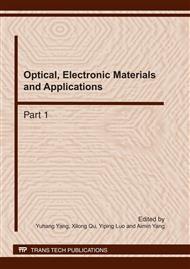[1]
M. Gilo, et al., Thin Solid Films Vol. 350 (1999) p.203.
Google Scholar
[2]
K. Yamamoto, et al., Appl. Phys. Lett. Vol. 81 (2002) p. (2053).
Google Scholar
[3]
G.M. Rignanese, et al., Phys. Rev. B Vol. 69 (2004) p.184301.
Google Scholar
[4]
J.C. Garcia, et al., Appl. Phys. Lett. Vol. 85 (2004) p.5022.
Google Scholar
[5]
X. Zhao, et al., Phys. Rev. B Vol. 65 (2002) p.233106.
Google Scholar
[6]
R. Terki, et al., Mater. Lett. Vol. 62 (2008) 1484.
Google Scholar
[7]
Z.J. Wang, et al., J. Crystal Growth Vol. 281 (2005) 452.
Google Scholar
[8]
F.L. Martínez, et al., J. Phys. D: Appl. Phys. Vol. 40 (2007) p.5256.
Google Scholar
[9]
M. Toledano-Luque, et al., J. Appl. Phys. Vol. 102 (2007) p.044106.
Google Scholar
[10]
J. Aarik, et al., Thin Solid Films Vol. 466 (2004) p.41.
Google Scholar
[11]
K. Kukli, et al., Microelectron. Eng. Vol. 84 (2007) p. (2010).
Google Scholar
[12]
C.A. Ponce, et al., J. Phys.: Condens. Matter Vol. 20 (2008) p.045213.
Google Scholar
[13]
R.A. Casali, et al., J. Phys.: Condens. Matter Vol. 17 (2005) p.5795.
Google Scholar
[14]
Q. Liu, et al., Physica B (2009), doi: 10. 1016/j. physb. 2009. 06. 061.
Google Scholar
[15]
R. Terki, et al., Comput. Mater. Sci. Vol. 33 (2005) p.44.
Google Scholar
[16]
J.P. Perdew, et al., Phys. Rev. B Vol. 46 (1992) p.6671.
Google Scholar
[17]
M.D. Segall, et al., J. Phys.: Condens. Matter Vol. 14 (2002) p.2717.
Google Scholar
[18]
J. Wang, et al., J. Mater. Sci. Vol. 27 (1992) p.5397.
Google Scholar
[19]
G. He, et al., Appl. Surf. Sci. Vol. 253 (2007) p.3413.
Google Scholar
[20]
J.C. Garcia, et al., AIP Conf. Proc. Vol. 772 (2005) p.189.
Google Scholar
[21]
B.H. Koh, et al., J. Appl. Phys. Vol. 95 (2004) p.5094.
Google Scholar
[22]
W.J. Zhu, et al, IEEE Elec. Dev. Lett. Vol. 23 (2002) p.97.
Google Scholar
[23]
Y. -C. Yeo, et al., Appl. Phys. Lett. Vol. 81 (2002) p. (2091).
Google Scholar
[24]
R.C. Fang: Solid Spectroscopy (Chinese Science Technology University Press, Hefei 2003).
Google Scholar
[25]
Y. Zhang, W.M. Shen: Basic of Solid Electronics (Zhe Jiang University Press, Hangzhou 2005).
Google Scholar
[26]
S. -G. Lim, et al., J. Appl. Phys. Vol. 91 (2002) p.4500.
Google Scholar
[27]
H.L. Chen: Advanced Inorganic Chemistry (Advanced Education Press, Beijing 2005).
Google Scholar
[28]
D.K. Pan, C.D. Zhao, Z.X. Zheng: Structure of Matter (Advanced Education Press, Beijing 1989).
Google Scholar


